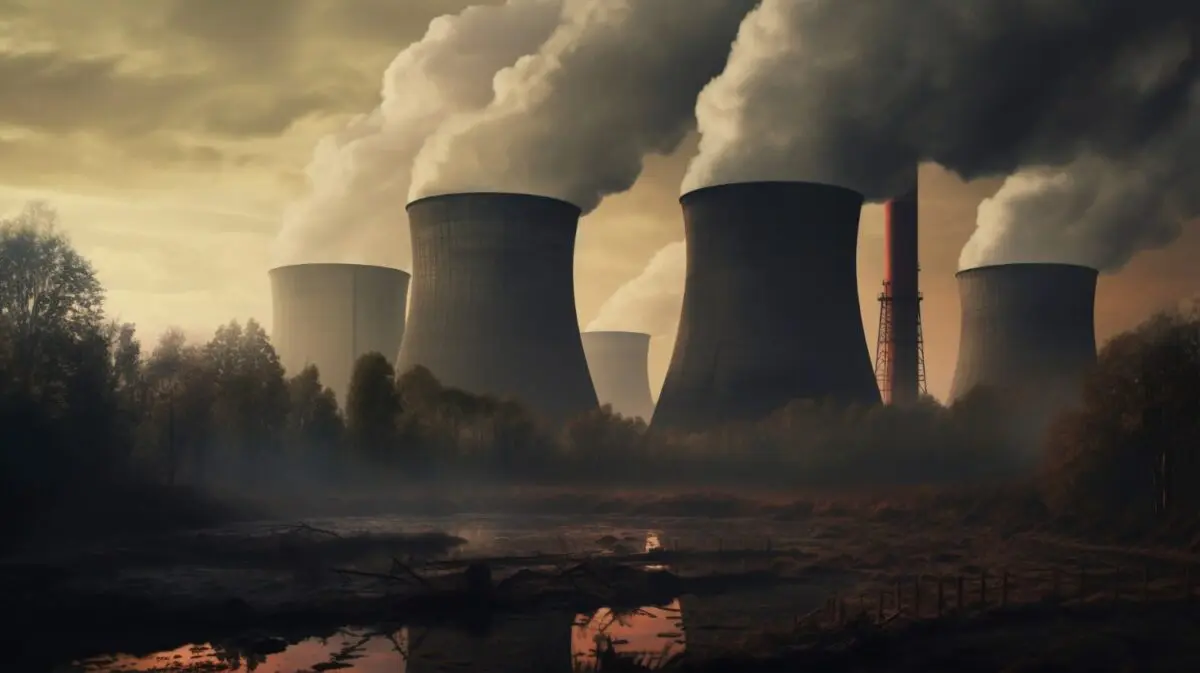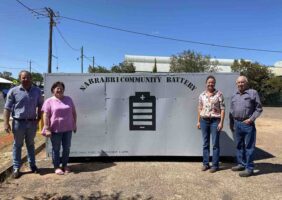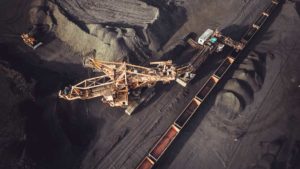The Coalition’s nuclear power policy is being released in instalments in the Australian newspaper ahead of its formal release sometime before the May budget.
Under a plan taken to the Coalition shadow cabinet in March, seven coal regions have been identified as potential locations for nuclear power plants, the Australian reports.
Presumably those regions are Collie in WA, the Latrobe Valley in Victoria, the Hunter Valley and Lithgow in NSW, and three regions in Queensland — the Darling Downs, Gladstone and Central Queensland.
The Australian reports that a shadow cabinet subcommittee will produce ‘economic impact statements’ to promote the potential economic benefits in the seven regions.
The Coalition will try to win local support by using taxpayer funds to reduce power bills for people living near the proposed nuclear plants. Workers will be offered higher-paid jobs, presumably at taxpayers’ expense. And taxpayers will be on the hook for workforce training, regulation, waste disposal and much more.
The plan “will involve the creation of new precincts for advanced manufacturing centred on cheap energy from small nuclear reactors”, the Australian reports. Cheap nuclear power will attract heavy industry, adding to the high-paid jobs bonanza.
A “community engagement process” would be rolled out once the coal sites had been identified, opposition leader Peter Dutton says.
But just like everything else associated with the Coalition’s nuclear policy, the plan to win over communities in coal regions has hit a snag.
The Murdoch press reported on April 7 that focus group research carried out in the Hunter Valley in NSW and the Latrobe Valley in Victoria found that voters are “hostile” to plans for reactors in their own areas.
An unnamed Coalition MP said of the Liberal and National Party rooms: “My read is they’re in a panic about it. They don’t know what to do.” A Coalition frontbencher said Dutton is “obsessed with this nuclear thing — obsessed with it.”
Rolls-Royce reactors
“There is every reason to be optimistic about bringing small modular net-zero emission nuclear into the power mix in the 2030s,” Dutton told the Australian.
Indeed he has “pledged” that if the Coalition were returned to government at the next election, the first nuclear reactors would be up and running by the mid-2030s. That’s a big pledge since there is zero chance of reactors operating in Australia by the mid-2030s.
Dutton recently met privately with executives from Rolls-Royce to discuss “the pursuit of low-cost small modular reactor technology for Australia”, the Australian reports.
Rolls-Royce claims it could build a reactor in Australia in just four years (once licensing and a myriad of other issues were sorted). Let’s compare that speculation with real world experience:
* Hinkley Point in the UK was supposed to be a seven-year reactor construction project but that has blown out to 12-13 years with further slippage likely.
* The one EPR reactor under construction in France was meant to be a five-year construction project but it remains incomplete after 17 years.
* The one EPR reactor recently completed in Finland was meant to be a four-year construction project but ultimately took 17 years to complete.
* The two AP1000 reactors in the US state of Georgia were meant to be completed in three years but ultimately took 10 and 11 years to complete.
Rolls-Royce’s 470 megawatt (MW) design is being marketed as a small modular reactor (SMR) even though it falls well outside the <300 MW definition of SMRs.
Only two SMR plants are said to be operating anywhere in the world (though there’s nothing modular about either of them). Russia’s floating ‘SMR’ was supposed to be a three-year construction project but that blew out to 12 years (and costs increased six-fold). China’s ‘SMR’ was supposed to be a four-year construction project but that blew out to nine years (and costs increased three-fold).
Rolls-Royce claims it could build a 470 MW reactor in Australia for A$3.5-5 billion. That equates to A$7.4-10.6 billion / gigawatt (GW). For comparison, the cost for the two EPR reactors under construction at Hinkley Point, the only reactor construction project in the UK, is A$27.8 / GW.
So Rolls-Royce claims its cost-per-GW will be just 27-38 percent of the cost of Hinkley Point, for a reactor type that it has never built and doesn’t have a licence to build, anywhere in the world. Rolls-Royce’s cost claim is implausible.
Since 2015, 13 of the UK’s 14 coal power plants have closed. Since 2012, 20 coal or oil plants have closed. Not one of them was replaced with nuclear. The only nuclear construction project is on the site of an existing nuclear plant.
The US experience
Citing experience in the US, shadow energy minister Ted O’Brien told the Australian: “The evidence keeps mounting that a coal-to-nuclear strategy is good for host communities, and especially workers as zero-emissions nuclear plants offer more jobs and higher paying ones.”
That would be the ‘evidence’ from the US experience of replacing zero coal plants with nuclear. O’Brien went on to berate “elitist and arrogant” politicians who want to “deny optionality to high energy-IQ communities”.
These ‘high energy-IQ communities’ will soon learn that 290 coal plants closed in the US from 2010 to May 2019, and plenty more since then, and not one of them was replaced by nuclear.
The only three reactor construction projects in the US this century have been on existing nuclear sites: the Vogtle project in Georgia, the V.C. Summer projected in South Carolina, and the Watts Barr-2 project in Tennessee.
O’Brien is excited by a US Department of Energy report estimating that leveraging existing infrastructure at coal sites could reduce reactor costs by 30 percent compared to a greenfield site. In fact the report estimates cost reductions of 15-35 percent but let’s use Ted’s 30 percent figure and see how it stacks up:
| Lazard’s levelised cost estimate for large reactors (US$141-221 / megawatt-hour (MWh), A$214-336 / MWh), minus 30 percent | A$150-235 / MWh |
| CSIRO 2030 estimate for SMRs (A$212-353 / MWh), minus 30 percent | A$148-247 / MWh |
| CSIRO 2030 estimate for 90 percent wind and solar with integration costs (energy storage and transmission) | A$69-101 / MWh |
Nuclear is still far more expensive, even with that improbable, speculative 30 percent reduction. Those living near nuclear reactors might have their power bills reduced at taxpayers’ expense according to the Coalition’s plan. Everyone else will be paying full price for nuclear power, plus additional taxes to subsidise the power bills of people living near reactors.
Wyoming
O’Brien is excited about nuclear startup Terrapower’s plans to replace a coal plant with nuclear in Wyoming. But Terrapower, founded by Bill Gates, is at the very early stages of a long, expensive licensing process for a first-of-a-kind reactor belonging to a class of reactors with a history of failure — sodium-cooled, fast-neutron reactors.
Physicist Dr. Edwin Lyman from the Union of Concerned Scientists, author of a detailed 2021 report on unconventional reactor types, says: “When it comes to safety and security, sodium-cooled fast reactors and molten salt-reactors are significantly worse than conventional light-water reactors.”
An article in the Bulletin of the Atomic Scientists — co-authored by Allison Macfarlane, a former chair of the US Nuclear Regulatory Commission — states that “molten salt reactors and sodium-cooled fast reactors — due to the unusual chemical compositions of their fuels — will actually exacerbate spent fuel storage and disposal issues.”
The coal plant near the town of Kemmerer in Wyoming will close in 2025. The projected startup of Terrapower’s ‘Natrium’ reactor has been pushed back from 2028 to 2030 and will certainly slip further.
The Wyoming coal-to-nuclear project could easily fall over, as others have. David Schlissel from the Institute for Energy Economics and Financial Analysis authored a 2022 analysis of the NuScale reactor project in Idaho and accurately predicted its demise. He predicts the same fate in Wyoming: “There’s every reason in the world to believe that [the Natrium project in Wyoming] is going to be a bigger financial disaster.”
Ominously, TerraPower CEO and president Chris Levesque recently declined to provide an updated cost estimate for the Natrium project. In 2020, the estimate was US$1 billion for a 345 MW reactor; in 2022 the estimate was US$4 billion.
Political responses
Prime Minister Anthony Albanese told the Australian:
“Eleven coal-fired power plants have already closed and the former Coalition government didn’t lift a finger to help workers in these communities. Rather than playing politics with the transition, the government is putting in place practical measures to ensure workers are looked after.
“The Net Zero Economy Authority will support workers to access new employment and to help create jobs in new businesses and industries. The Energy Industry Jobs Plan introduced into parliament last week outlines a redeployment scheme to align workers with jobs in new industries. The authority will work with business unions and communities. We will not leave them behind.
“A practical example is the Liddell site in the Upper Hunter which is being transformed into an energy and manufacturing hub, employing more people than the old power station did.
“Recently, Rio Tinto signed Australia’s biggest renewable energy deal to power its Boyne aluminium smelter in Gladstone.”
The Coalition won’t be fussed by a critical response from Labor. But its coal-to-nuclear plan has received hardly any support whatsoever outside the Murdoch-Sky echo-chamber and the far-right of Australian politics.
And it is attracting plenty of friendly fire. Former Liberal prime minister Malcolm Turnbull says nuclear power’s only utility is as “a means of supporting fossil fuels by delaying and distracting the rollout of renewables” and that nuclear power “is exactly what you don’t need to firm renewables.”
Former Liberal leader John Hewson says Dutton may be promoting nuclear “on behalf of large fossil-fuel donors knowing nuclear power will end up being too expensive and take too long to implement, thereby extending Australia’s reliance on coal and natural gas”.
NSW Liberal MP and former deputy premier Matt Kean says “there is no feasible pathway [for nuclear power] to play any material role in helping Australia replace our coal fired power stations in line with the climate science.”
Liberal MP Bridget Archer recently told the Nine newspapers that nuclear power should be pursued only if coupled with a rapid surge in renewables and that nuclear power should not be used as an excuse to prolong fossil fuel reliance.
Dutton’s coal-to-nuclear plan has received no support from Liberal opposition parties in any states with coal-fired power plants.
Victorian Liberal leader John Pesutto says he does not support building a nuclear power station in the La Trobe Valley and shadow energy minister David Davis said “the Victorian Liberals and Nationals support a commonsense transition to renewables that ensures affordability and security of supply”.
Queensland LNP leader David Crisafulli is openly opposing Dutton’s nuclear plan.
WA Liberal opposition leader Libby Mettam says she has made it clear to her federal colleagues that nuclear energy does not stack up in WA.
NSW opposition leader Mark Speakman is letting his federal colleagues down gently, saying he is awaiting the details of the nuclear plan and that “at the end of the day we have to have energy sources that are clean, cheap and reliable”.
According to Dutton, “If we win the election, it is clear to me that [SA Labor Premier] Peter Malinauskas would be the first to sign up”. But SA has gone from 1 percent renewable electricity supply to 74 percent over the past 16 years and aims to reach 100 percent net renewables by 2027.
According to the SA government, SA has attracted over $6 billion investment in large-scale renewable energy and storage projects to date with over $20 billion in the investment pipeline. The last SA coal power plant, near Port Augusta, was shut down in 2016 and the region has since become a renewables hub.
Are Dutton and O’Brien unaware of these things? Are they planning a renewables-to-nuclear transition in SA?
And did they miss Malinauskas saying: “Every single objective, independent analysis that has looked at this has said nuclear power would make power more expensive in Australia rather than cheaper. Why we would impose that burden on power consumers in our country is completely beyond me. Maybe one day in a hundred years time nuclear technology might evolve.”
Independent MP Monique Ryan says the Coalition “is kicking the can down the road on the transition because they want to keep in with their friends”, the big coal and gas suppliers.
Independent MP Allegra Spender says: “AGL Energy, Alinta, EnergyAustralia and Origin Energy have all dismissed nuclear. The community does not trust the Coalition’s commitment to climate action, and their current stance reinforces it.”
Other responses
Shadow energy minister Ted O’Brien claims that promoting nuclear power is “indicative of how serious the Coalition is when it comes to getting to net zero.”
But the Coalition is divided on the issue of net zero and it is infested with anti-renewables, pro-fossil fuels, science-denying ideologues. Malcolm Turnbull says the “science denying” element in the Coalition is “crazy, and to some extent getting crazier”.
O’Brien says the growth of renewables in Australia is something to be “enormously proud of”. But the growth has largely occurred despite and not because of the Coalition.
The Coalition opposes the government’s target of 82 percent renewables by 2030 and wants to expand gas and prolong the use of coal. At the COP28 climate conference in December, the Labor government joined 120 countries in backing a pledge to triple renewable energy and double the rate of energy efficiency by 2030 — a pledge opposed by the Coalition. The Nationals are calling for a moratorium on the rollout of large-scale renewables.
In that context, it’s not surprising that the Coalition’s coal-to-nuclear plan is going down like a lead balloon.
The Guardian reported on March 19 that Australia’s big private electricity generators — AGL Energy, Alinta, EnergyAustralia and Origin Energy — have dismissed nuclear energy as a viable source of power for their customers for at least a decade and say they will remain focused on developing renewable sources as coal and gas plants exit the grid. One senior executive told the Guardian that power bills would triple if nuclear power was pursued.
AGL chief executive Damien Nicks warns that the nuclear debate risks derailing critical investment in the energy transition. AGL reportedly plans 12 gigawatts of new renewable and firming capacity by 2035.
Nicks said: “There is no viable schedule for the regulation or development of nuclear energy in Australia, and the cost, build time and public opinion are all prohibitive. … AGL is already developing our coal and gas power station sites into low-emissions industrial energy hubs. … As the owner of these sites, nuclear energy is not a part of these plans.”
A recent survey by the Investor Group on Climate Change asked big institutional investors with $37 trillion under management which energy and climate solutions they believed had good long-term returns. Nuclear power was ranked last of the 14 options, renewable energy first. Nuclear power’s last placing was due to its “very high cost, and the lack of maturity and deployment in next-generation technologies,” the Investor Group said.
Former Chief Scientist Dr Alan Finkel says that “any call to go directly from coal to nuclear is effectively a call to delay decarbonisation of our electricity system by 20 years.”
Another former Chief Scientist, Robin Batterham, says that: “To reduce renewable targets in the belief that nuclear will be deployed later at scale would create a material risk of not achieving net zero, or doing so at an excessive cost.”
The Australian noted the Australian Workers Union’s support for nuclear power but didn’t mention the opposition of the Australian Council of Trade Unions, Australian Education Union, Australian Manufacturing Workers Union, Australian Nursing and Midwifery Federation, Australian Services Union, Communication Workers Union, Electrical Trades Union, Independent Education Union (Vic – Tas), Maritime Union of Australia, National Union of Workers, Tasmanian Unions, Unions ACT, Unions WA, Unions SA, Unions NT, United Voice, United Firefighters Union, and the Victorian Trades Hall Council.
Climate 200 founder Simon Holmes à Court states: “With nuclear unlikely to contribute anything before the 2040s and most of our coal power exiting years earlier, the Coalition is condemning us to burning orders-of-magnitude more gas and likely blackouts. In rekindling the climate wars, under Coalition policy, not only would we all pay higher energy bills, we’d squander Australia’s once-in-a-generation opportunity to become a prosperous, clean energy superpower.”
Holmes à Court has carried out calculations based on the assumption that the Coalition’s plan would slow the deployment of renewables, prolong coal, build nuclear, and fill the gaps with gas. The result, he says, would be burning 19,000 PJ more gas, burning 255 Mt more coal, increasing emissions by 2,100 MtCO₂, and spending $200bn+ more on electricity up to 2050.
Economist Prof. John Quiggin notes that, in practice, support for nuclear power in Australia is support for coal and he has described nuclear advocacy in Australia as a dog whistle to climate denialists.
Dr. Jim Green is the national nuclear campaigner with Friends of the Earth Australia and a member of the Nuclear Consulting Group.






